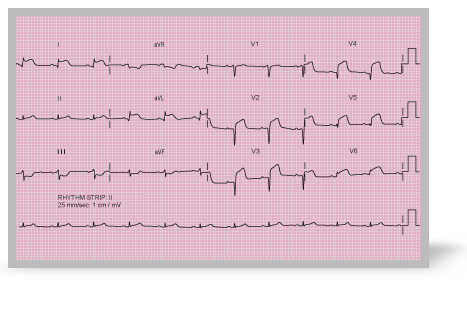
- Question two
The subsequent management of the patient whose ECG you have just seen will include:

Feedback
That’s partly right. Have another go.
Feedback
That’s partly right.
In patients presenting with an ST elevation myocardial infarction, emergency coronary reperfusion should be achieved if possible. In patients presenting within 12 hours of the onset of pain, where time to percutaneous coronary intervention (PCI) can be achieved within 90 minutes then PCI is the preferred method of reperfusion therapy.
In the meantime all patients with an acute coronary syndrome should be given platelet inhibitors, nitrate, oxygen and analgesia to relieve symptoms and limit myocardial damage.
Feedback
That’s not right. Have another go.
Feedback
That’s not right.
In patients presenting with an ST elevation myocardial infarction, emergency coronary reperfusion should be achieved if possible. In patients presenting within 12 hours of the onset of pain, where time to percutaneous coronary intervention (PCI) can be achieved within 90 minutes then PCI is the preferred method of reperfusion therapy.
In the meantime all patients with an acute coronary syndrome should be given platelet inhibitors, nitrate, oxygen and analgesia to relieve symptoms and limit myocardial damage.
Feedback
That’s right.
In patients presenting with an ST elevation myocardial infarction, emergency coronary reperfusion should be achieved if possible. In patients presenting within 12 hours of the onset of pain, where time to percutaneous coronary intervention (PCI) can be achieved within 90 minutes then PCI is the preferred method of reperfusion therapy.
In the meantime all patients with an acute coronary syndrome should be given platelet inhibitors, nitrate, oxygen and analgesia to relieve symptoms and limit myocardial damage.
